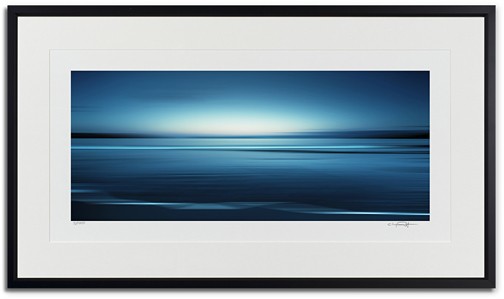In Pilgrim at Tinker Creek, Annie Dillard contends that “the secret of seeing . . . comes to those who wait for it, it is always, even to the most practiced and adept, a gift and a total surprise.â€Â No one knows this better than Louisville photo artist Chip Dumstorf, whose debut solo exhibit, LND&SEA, at the Fine Art Editions Gallery in Georgetown, KY presents a unique challenge to the mind’s eye of anyone who encounters this work.
The challenge commences with the missing “A” in the show’s title. Although it’s not there, your mind still sees it simply because of visual expectation. And so it is with the 16 images presented in this show. The pieces are numbered rather than titled, not an uncommon practice for many artists. Dumstorf stated that he did this for “practical†reasons because of the incredible number of images he generates in a single shoot, sometimes as many as three per minute. He then further explained that by not using titles, viewers are likelier to respond more spontaneously and personally to the work because they are forced to be with it in the moment, just as he was when he captured it and then later when he meticulously processed it.
LND&SEA #1 is a good case in point. When I first saw it, I immediately thought of Lina Wertmuller’s film, Swept Away by an Unusual Destiny in the Blue Sea of August. But that was an initial response. On gazing at it from a distance and up close, I think I went where Dumstorf intended, which was, in part, definitely an unusual destiny.Â
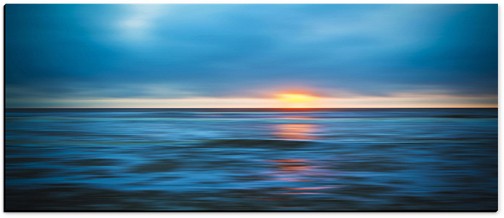
I became the particles of everything I saw, as real of an illusion as I have ever experienced. I say this because of Dumstorf’s process.  Out of deconstruction emerges a reconstruction of some of the most pristine scenes you will ever witness: nature as it was intended to be rather than what the human race has made of it. Here, the motion of the wind, which we cannot consciously see, is as much a factor as the dispersion of light from the setting (or rising) sun, the rhythmic undulation of the waves, the gentle wafting of the clouds over the water, and the fascinating spectrum of color these interdependent elements reflect. Shades of gray, hues of green, blue, pink, white, yellow and black. Through these trails of light, nothing is as it seems. Digital manipulation? Yes indeed. To the point of high art.
In the age of electronic and digital media, everybody has a camera and everybody takes pictures, but not everybody can create art. And not everybody is willing to travel up and down the east and west coasts of the U.S. and Central America, as Dumstorf has, to be in the moment, to capture that moment and convey its spirit through digital processing, as is adroitly and spectacularly demonstrated in LND&SEA #3.
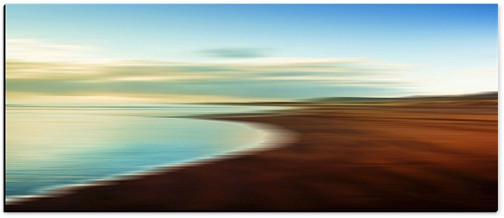
Mellifluous best describes this image because the scene is so soothing, rich and harmonious. Dumstorf is very much in step and in tune with his approach and like any good photographer, he must first be in the right place at the right time, realizing that he has an incredibly short time frame to make the catch. Then using the tools of his trade, he sculpts what nature has given him. The sea seems to have dropped out of the sky and as it reaches the shore, the gentle curves of the water’s edge are striated into the sand. The land has been rendered with a similar fluidity that could itself ebb and flow with the tide, or settle into its own windswept gradations of light.
Dumstorf’s technique of digitally adding by subtracting is probably best exemplified by the central piece of the exhibit, LND&SEA #12. In the style of a minimalist, he clearly shows that less is more. And using the backdrop that nature provides, sometimes with varying degrees of clutter and visual white noise, Dumstorf painstakingly removes what he considers distractions, which may be anything from a person, to sail boat, to a bird, to a sea shell, or even an oil rig. Criticize as you may, it’s almost like a baptism when his fastidious cleansing and enhancement of nature’s palette creates such breathtaking, mesmerizing vista of absolute serenity—a place we would all love to be.
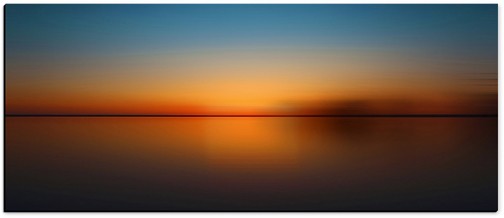
Not all of his work, however, exudes this same aesthetic quality. Yet it is just as interesting and valid as anything that can be pulled out of thin air. In fact, it’s stunning. Undoubtedly the most intense and abstract piece in the show is LND&SEA #5, shot in early afternoon light, one of the least popular times of day for most photographers.
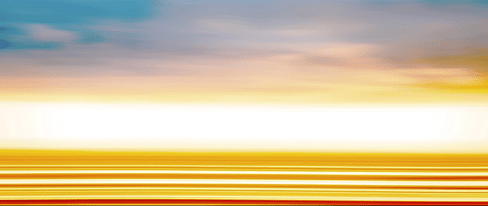
Light is energy and energy generates heat. Dumstorf said he was curious as to whether or not he could reduce the harshness of this particular landscape to its most basic components and still impart its true nature. Well, he did. And if you look at it long enough, you may begin to perspire. The heat rises from the bottom of the canvas, starting with fiery red, as strips of alternating color waver outward and upward in luminous tones of yellows, whites, and oranges into the blinding white that dominates the middle of the composition in the way that the sun dominates the middle of the day. The only respite is the cool blue that bathes the lingering wisps of clouds.
LND&SEA #5 represents the epitome of Dumstorf’s ability to see, and his willingness to be totally present when he photographs. It also underscores his technical ability to visually communicate an abstraction that is difficult to put into words except for, “Man, it’s hot outside.â€Â Annie Dillard speaks directly to his presence and his gift when she says, “I cannot cause light; the most I can do is try to put myself in the path of its beam. Light, be it particle or wave, has force: you rig a giant sail and go. The secret of seeing is to sail on solar wind. Hone and spread your spirit till you yourself are a sail. . .â€Â This is Dumstorf’s destiny.
LND&SEA runs through November 6th at Fine Art Editions Gallery in Georgetown, Kentucky. The exhibit includes matted and framed prints, as well as images on canvas.Â
